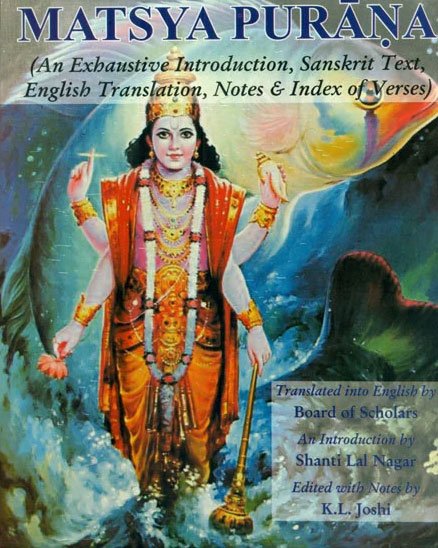The Matsya Purana (critical study)
by Kushal Kalita | 2018 | 74,766 words | ISBN-13: 9788171103058
This page relates ‘Religious Aspects of the Puranas (Introduction)’ of the English study on the Matsya-purana: a Sanskrit text preserving ancient Indian traditions and legends written in over 14,000 metrical verses. In this study, the background and content of the Matsyapurana is outlined against the cultural history of ancient India in terms of religion, politics, geography and architectural aspects. It shows how the encyclopedic character causes the text to deal with almost all the aspects of human civilization.
Religious Aspects of the Purāṇas (Introduction)
The Purāṇas are established as important religious literature, which are rooted in Vedic literature. But during the Purāṇic age the Hindu religion emerged with a new look which was different from the Vedic ideas of worshipping gods and goddesses. In that period the Vedic yajña lost its importance as they adopted the vratas, upavāsas, prāyaścittas, dānas, dikṣās etc. as the means of worshipping deities prescribed in the Purāṇas. In the Vedic period, the common people including the śūdras and women were ignored in religious activity, while Purāṇas advocated the theory of equality where all people could worship any deity irrespective of caste, creed and sex. Not only is the system of worshipping changed in the Purāṇic period, but the importance of different gods also changed. Amongst the gods Viṣṇu, Śiva and Brahmā acquired the most eminent positions in the Purāṇas, whereas in the Vedic period these three gods were regarded as associate or minor gods. The Purāṇas bestowed Viṣṇu and Śiva such a prominence that all the other deities from the Vedic age were demoted to the second or third category.
In the words of Goyal,
“In the transformed pantheon the most eminent position was occupied by Vishnu (once a mere accomplice and associate of Indra in latter’s exploits against the asuras) and Rūdra Śiva (once regarded as minor malevolent deity) and Brahmā (who in the early Vedic age were nowhere in the picture). These three, specially the first two, shot themselves into such a great prominence that all other deities were thrown into second rate, positions. In the personality of these three were now coordinated the three principles of creation, preservation, and destruction. Thus was borne the triad or trinity of Indian pantheon recognized by the Epics and Purāṇas.”[1]
The Purāṇas have clearly mentioned about the three triads and their cosmic functions. According to the Matsyapurāṇa, the origin of the trinity is from one Supreme Being. The three gods Brahmā, Viṣṇu and Maheśvara are different menifestations of the one and the same Supreme Being. They take manifestations when the three guṇas sattva, rajas and tamas are disturbed. In the Matsyapurāṇa, the names of the members of the trinity occur together in a compound or separately. They are Brahmā, Viṣṇu and Maheśvara[2] or Viṣṇu, Arka and Rudra[3] or Brahmā, Viṣṇu and Indra.[4] In the Matsyapurāṇa, it is mentioned that Brahmā creates all the living beings and inanimate matter, lord Viṣṇu preserves them and at the end of the term Rūdra destroys them.
Along with the worship of this triad, the data of goddess worship is also available throughout the Purāṇic works. Therefore, in this chapter, the religious aspects of the Matsyapurāṇa will be discussed under these three main heads, viz., Vaiṣṇavism, Śaivism and Śāktism corresponding to the faiths and worshiping practices on Viṣṇu, Śiva and Śakti who is the goddess of Power respectively and also the vratas, dānas etc. mentioned in this Purāṇa.
Footnotes and references:
[2]:
Matsyapurāṇa, 68.27
[3]:
Ibid., 92.1
[4]:
Ibid., 192.7
